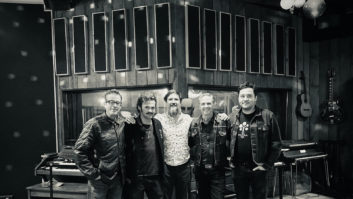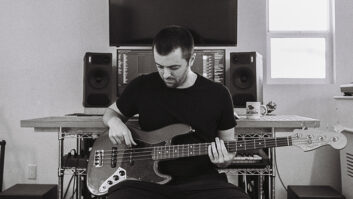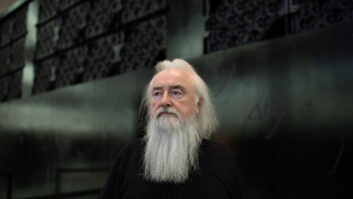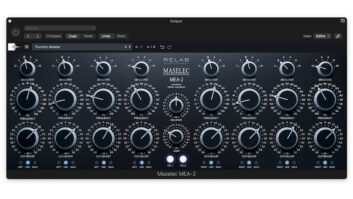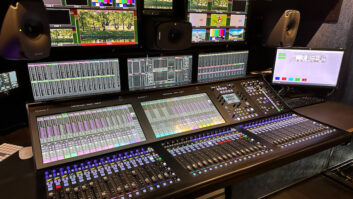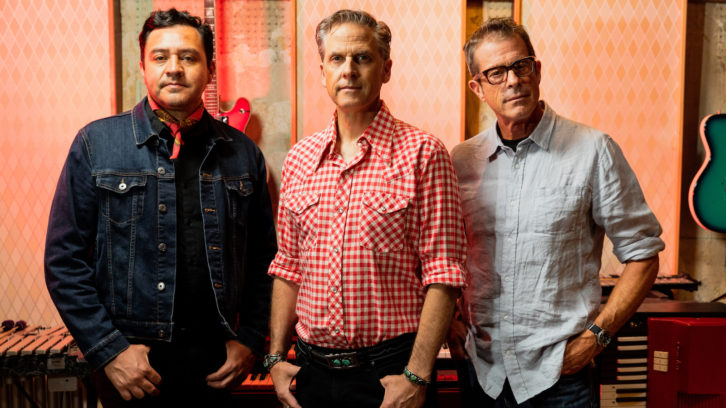
We pick up from Part 1 mid-tracking, with Calexico (Sergio Mendoza, Joey Burns and John Convertino) working in Mendoza’s new personal studio, built out of shipping containers. Recording with recording engineer Chris Schultz and engineer/producer Tucker Martine, the album continued to progress.
During band tracking, Schultz set Mendoza and Convertino up together in the big room, while Burns played guitar and sang a scratch vocal in the iso room.
“The sightlines were a little tricky, but we got it to work,” Schultz says. “There’s a large window and a glass door for the little iso booth, and you could use that to see through the big window that looks into the control room, so even though John was in a corner in the main room, he could see Joey through the control room. That helped because they were mostly tracking together.
Sergio would play bass, keyboards or something else as they were writing songs and doing basic tracking, and then he would overdub other parts afterward.”
Schultz brought his own Genelec 8040B monitors to the sessions, as well as a number of pieces from his mic collection. For Convertino’s kit, which comprises Ludwig and Gretsch drums, he used a Blue Kiwi on kick, Shure SM57 on snare, Violet Designs Amethyst Vintage overheads, Sennheiser 421s on toms and an Audio-Technica 450 on hi-hat.
Burns’ amp was captured via another 57 and an A-T ATM450, going through Schultz’s Rupert Neve Designs 5012 mic pre.
“Joey would often start out tracking with an acoustic, though, and that was through the Voodoo VR1 and the Audio-Technica 450,” Schultz says. “Those went into that Rupert Neve 5012, as well.”
The overdub phase added contributions from many of their musical compatriots, including bass player Scott Colberg, trumpet players Jacob Valenzuela and Martin Wenk, and guest vocalist Gaby Moreno, as well as Johnny Contreras (vihuela, guitar), Antonio Pro (guitarron), David Gill (violin), and others. Pro and Gill joined Calexico in Mendoza’s place, while others flew in parts to add to Schultz’s rough mixes.
“We’ve known some of these guys for 20 years,” Burns says. “David Gill and Tony Pro teach mariachi in Tucson, and they brought in some of their students to play the other violin parts on ‘The El Burro Song.’ They also did gritos, the shouts, on that song. I also do one on the break on that record. We just had a lot of fun.”
MIXING WITH MARTINE
Calexico then took all of the Pro Tools tracks and Schultz’s roughs up to Portland, Ore., to mix in Martine’s studio, Flora Recording & Playback.
“They gave me a lot of freedom up front, and my instinct was to go toward a lot of saturation and to embrace a kind of ‘mid-fi’ aesthetic, where some things are low-fi, others are hi-fi, and then there’s the stuff in the middle that connects everything,” Martine explains. “I always like hi- fi more when there’s something kind of dirtier sitting next to it.”
Martine points to the horn parts that he “dirtied up” quite a bit. “I made a bus for the horns and I just leaned into the Sound Toys Devil Loc,” he says. “That’s an emulation of an old podium compressor that Shure made called the Level Loc that Tchad Blake made famous by abusing so successfully. It has just a couple of knobs on it, basically: crunch and darkness. The distortion is brash, but you can round it out.”
Other key elements to Martine’s mix included the Thermionic Culture Vulture and a UREI 1176 on bass, and his EMT 140 plate reverb on Burns’ lead vocal.
“I was also using the Great British Spring reverb,” Martine says. “It’s a rare old box that consists of a 3- or 4-foot spring in a 5-inch round, black plastic tube. It really sounds much more like a plate than a spring, but it’s brighter than my plate. It allowed things to sound like they were from the same universe without clouding each other up.”
Like Burns, Martine emphasizes the importance of real-life reconnecting in the studio: “While they were here, we fell into a rhythm where, by mid-afternoon, people would start preparing dinner. John, in particular, loves to cook Italian food,” he says. “By about 5 o’clock, I’d start noticing these aromas coming from the studio kitchen. It added a familial atmosphere to that time of day when the mix is getting close and dinner’s going to be ready soon.
“It was September, and the weather was warm, so after we’d had some food and maybe a glass of wine, we’d throw the mix on through my outside speakers. If the mix seemed to be lacking anything, it usually would be really obvious in that situation.”

